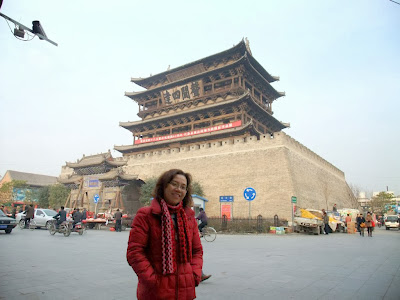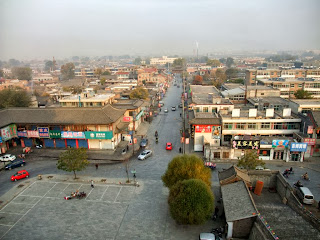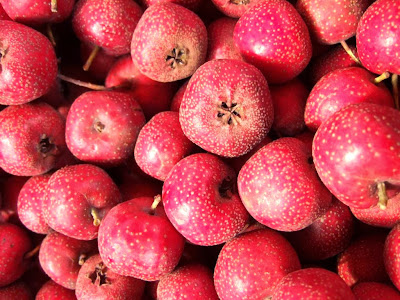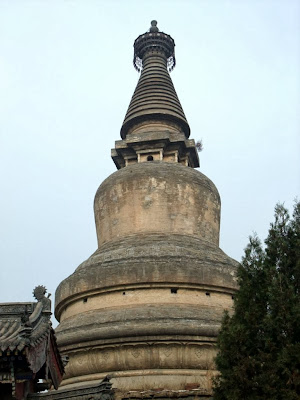
Daxian (代县) was a historical town as it was an important trade and military center of Northern China in the past. Many Chinese famous general like Shi-rengui (蒒仁贵), Li-mu (李牧), Yang-ye (杨业) and Guo-ziyi (郭子仪) had been stationed here to defend the invasion of northern nomad tribes. There were more than 150 battles fought within this area during the past 2000 years. The famous Yanmen Pass (雁门关) which was part of The Great Wall, was built 20 km northwest of Daxian at the ridge of Gouzhou Mountain.



The city wall of Daixian restored and repaired during Ming Dynasty (1368-1644) was basically quite well preserved. The magnificent wooden drum tower Bianjing-lou (边靖楼) was situated right at the center of the Daixian Town.



Bianjing-lou (边靖楼) also named as Qiao-lou (樵楼) was built by a Ming dynasty marquis Lu-heng (陆亨) in year 1375. The tower was destroyed by fire in year 1472 but soon rebuilt 5 years later, financed by Ming General commander Liu-chong 刘宠 and minister Chai-lin (蔡麟). It had gone through lots of repairs during Qing Dynasty (1644-1911).




The two wooden plague hanged at southern side of the tower were made in year 1733 during the reign of Emperor Yong-zhen in Qing Dynasty. The four huge Chinese character read as shen-wen-si-ta (声闻四达) meaning sound of the drum able to reach all directions. Measured as 10 meters long by 3 meters wide, it boasts to be one of the largest wooden plague in China.


Bianjing-lou was a three storey wooden structure with about 40 meters in height. The building measures as 43 meter in length and 33 in width. It shares the fame with Ying-ju Wooden Pagoda (应具木塔) .



The inscription at stone stele clearly indicated the details of the repair work done in year 1733 during the reign of Yong-zheng in Qing Dynasty.



Elevation view towards north direction from its northern entrance.




The northern side of Bianjing-lou.



There are also two wooden plague at northern side which were also made in Qing Dynasty, same time as those in southern end of the tower. The plague which is as large as the one at southern side also inscribed with four Chinese characters read as wei-zhen-san-guan (威镇三关) meaning the powerful fame awe-inspiring the three inner defensing passes (Yanmen-Guan 雁门关, Ningwu-guan 宁武关 and Piantou-guan 偏头关).



The stair way ascending to the building at northern entrance.



The wooden frame windows.




Halls were surrounded by veranda, separated from wooden windows and doors.



The strong wooden bracket of the eaves.


An internal wooden steep stairway connecting one floor to another.



General Yang-ye and his family were great patriots famous within this area. Many of his family member statues were cast and displayed at the hall with written details of how they bravely fought and sacrificed for their nation in the battles.




Some historical equipments.



The clay models told us the story of the history how the inter-marriages and trade began to carry on between Han people and nomads of the north at that time, and how a Qing merchant looked like.



The ancient Chinese understood very well that to stop battles was the only way to attain prosperity


The history of early cultural exchange between Hans and nomadic tribes.


The history of early technical skill exchange between Hans and nomadic tribes.



A map briefly showing the distribution of towns before Han dynasty. Daixian is an important trade center in the past era.



The stone lamp was made in early Tang dynasty and repaired in song dynasty. The base is square in shape and cast into 5 peaks with one at center and 4 as burning caldrons representing Wutaishan. The 5 peaks were carved with passages, monks, 8 platforms inside a pond with clouds and windows at heavenly palaces. The four sides were inscribed with complimentary comments.



There are many of these history written boards.


The model of the significant Pass Yanmen-guan.



Proceeding to Southern side of the tower.



Exhibition of Chinese calligraphy.





Views from window.



The tower is actually circled up by lines of shop houses.



Daily activities at the base compound of the tower.


A view of the beautiful Daixian town.











Daixian town at dusk





The ancient King Asoka Relic Stupa stands just adjacent to the tower.


Daixian's sun set.




City wall under sunset



Daixian joyful ladies enjoyed their morning practices of tradition dances.



The bustling market just right in front of the tower.


The butcher


The fruit seller



The spices seller had a grinder ready to service his customers who wish to have their spices turned into powder.



Fertile soil provides many wild produces in Daixian like yam and wild cherry.



The fermented bean curd products, bean sprout and freshly grown mushroom



Most farmers brought their own produces and sold here. The women was promoting her grapes grown from her yards



The bun was made and sold at spot, cheap and tasty, chargeable at rmb 1.00 each or less.




Hand made snacks sold fresh from stove.



I loved the rice noodles so much, soup or dried were both delicious.


Compared to other stalls, this Beijing wulo was so much modernized. He used LED lights to attract customers attention.



His wulo varieties were really tempting



We were so happy to finally get to this ancient King Asoka Relic Stupa



We found out from the article that it was one of 19 Stupa in China that contains Buddha relic. It was first built in year 601 and named as Longxin. The stupa was originally built with wood material but after damages and several repairs in Tang Dynasty, it finally changed into brick in year 1275 after restoration.




The alms converted shape followed the style of Tibetan tradition.




It was rather disappointed that we did not have the chance to circle round this ancient Relic Stupa as it was locked and nobody knew where about was the person who hold the key. We left Daixian with regret, after waiting for 30 minutes.


Daixian Arch Gateway.


I like the warning phrases written on the banners advising all drivers to drive safely. It said "Safe along the whole way when give way along the way" and "Safety of a person is happiness of a family". "No speeding , no squeezing and no recklessly driving on highway, on small roads and on any way"



No comments:
Post a Comment